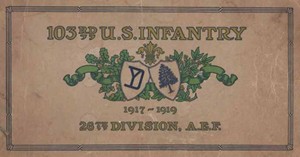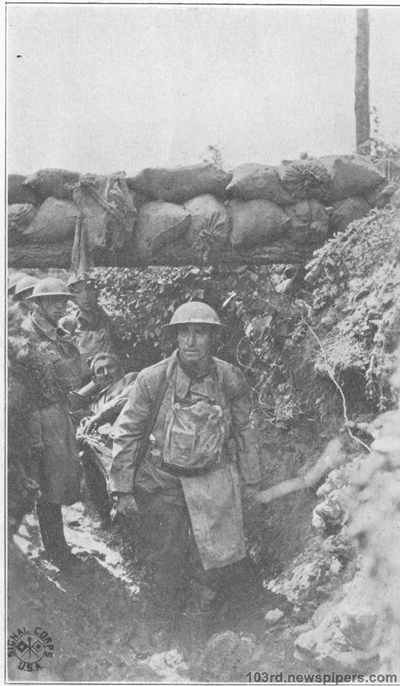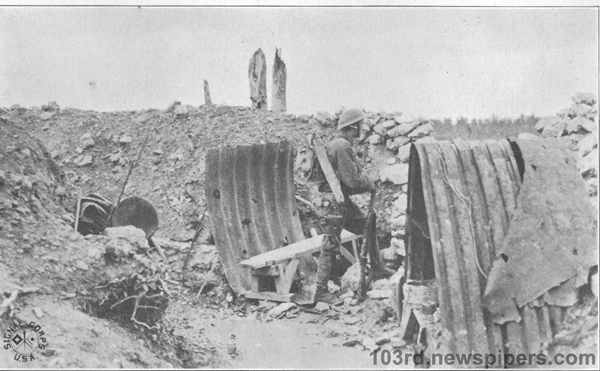
of the 26th Division of the U.S. Army
during World War I
 | The History of the 103rd Regiment of the 26th Division of the U.S. Army during World War I |
| Table of Contents | ||
 On the llth Sept., 1918, this
regiment was in position as fol-
lows:
The lst Battalion (Major Ilan-
son) plus l\laehine—Gu.n Com-
pany, 103rd Infantry was in
front line with Companies C and
D in front line in (LR. Liege,
with Company A less one pla-
toon in support in the same
center of Resistance. Company
B plus one platoon of Company
A in front line in C.R. Terrasse,
with Battalion Headquarters at
P.C. Liege.
The 2nd Battalion (Capt.
Shumway) was in support in
the Ravine South of the Foret
d’Amblonville.
The 3rd Battalion (Major
Hosford) was in Reserve in the
Forét d’AmblonviIle.
Regimental lh-aclquartersavere
at P.C. Neuilly in the ravine
with the 2nd Battalion.
The Battalions moved into
positionfor the attack on the
evening of 11th Sept. 1918. lt
was an extremely cliliieult under-
taking. Rain which had fallen
incessantly l' or several days made
the roads very heavy. All roads
leading to the front were blocked
for long distances by trafic,
which was apparently in no way
regulated. Owing to' the late
hour in which we received deli-
nite orders showing the plan of
attack, the zones of action, the
objectives, etc., nothing but
hasty reeonnaissances were pos-
sible. Ditferent units assigned
to us such as Engineers, Gus and Flame Troops and Artillery did not report
until late at night on the Ilt.h—12th Sept. 1918. Machine Gun Company, 103rd
Machine Gun Battalion was held up by blocked roads and was not able to
arrive until late. Promised ammunition for the Stokes Mortars did not arrive.
¥Ve were short of equipment and clips for the automatic rifles had to be carried
in sand bags. It was raining heavily and the night very dark. Plans for liaison
with units on our right and left were necessarily very hurriedly made. Com-
munication to the rear was very limited, owing to the very bad condition and
shortage of telephone wires.
The ltepgimental P.C. was moved forward to the P.C. Cloehc and shortly after
1:00 o'elock, 12th Sept. l9l8, the Battalion (lonirnanders reported themselves in
position. An advance message center was established at P.C. Durant and telo-
phone wires were layed to our extreme front line.
The 2nd Battalion (Capt. Shumway) was to make the assault, followed by the
3rd Battalion (Major Hosford) as Support at 1000 meters with the lst Battalion
(Major Hanson) at 1000 meters as Reserve.
The terrain in front of and including our pusitinrm was extremely clillieult to
pass ever lmiuix pitted with old trenches and neveimml with tangled masses of old
wire. A detail of Battalion Scouts under liieulrenairls Foss, the Battalion In-
telligence Officer of the 2nd Battalion, worked t}n·0u;;lmut the night cutting lanes
to connect with the gaps in the enemy wire which were to be made by our
Artillery.
The barrage started at 1:00 0’eloek and continued until 8:00 1’:loek. The
one pounder Gun Platoon, 103rd lnfantry rendmwerl very valuable assistance in
ilemolghing Machine Gun nests in the enemy liuu which had previously been
ocate .
The enemy replied at First with bursts of Machine Gun fire and mimmnweufer,
evidently expecting rt raid. At l:1yl>r¤-ak all of our men were fed and hot coffee
issued.
Promptly at 8:00 o'cl0ck, following the rolling B;u·rage, the 2nd Bzitlnlion went
over the top, two companies in assault, deployed in waves, and 2 companies in
support.
Little resismuieu was encountered in the enemy l`i·a>nl, line, but when the 2nd
line was rearahexl, heavy Machine (`iun {irc was u11zmnLei·ecl. These nests were
flanled·and 7 machine guns captured. The mlvaiiue continued without check
until the enemy Trench "StctLin" was reached. A di-lay of 1 hour hccmne neces-
sary on account of Machine Guns. Platoens from the right and left, linally suc-
ceeded in working around them and with the aid of our own Machine Guns cap-
tured them.
The first halting place having been reached, the Battalion was luv.lt,0l and re-
formed. The Battalion entered the Chanob Bois. Two enemy field pieces were
captured here. An enemy ba1*1·a;;» necessitated retiring to the Northwest ern edge
ef the woods. The Battalion wmwlcerl around the Southwestern edge of the woods
and reached the Dominartin-Hill 381 Road. A patrol was sent into Dommartin
but was driven back by l\Iachine Gun Fire. Position for night was taken up in
abandoned enemy trenches Southwest of Chanot Bois by the assaulting Battalion
with the Support and Reserve Bzntmliens about 500 and 1000 meters in the rear
respectively. The assaulting Battalion, 104th Infantry at this time crossed
directly in front of our assaulting Battalion and took up its position on our right,
being entirely out ef its sector. The Commanding Ollicer, 2nd Battalion, 103rd
Infantry conferred with the Commanding OHic:>1·, assaulting Battalion, 1.04th
Infantry and the latter returned to its proper position.
Orders were received at midnight, 12th—13th Sept. 1918 1.0 push on Lo Vigneulles,
but these were subsequently ehan%ed giving us an objective of SL. Maurice, which
place must be reached at daybrca ’. As soon as possible the Last erclur was com-
municated to the 2nd Battalion. This order reached the Battalion late, owing to
the ground which had to be crossed and the darkness of the night.
At 5:30 o’¢lcIck, 13 Sept. 1,918, the advance was resumed and soon after the
Battalion www lirerl upon by snipers and Machine Guns from the l·`m·ét de la
Montagne. These were driven hack and captured as well as 3 enemy field pieces.
The enemy were apparently in full retreat, and the Battalion marched in the
direction of St. Maurice. The Battalion from the 104th Infantry again came into
our sector and marched over the road leading to SL. Maurice directly in advance
of our Battalion, thus slewing our advance to a great extent.
At 12:00 o'cl0ck, 13 Sept. 1918 our leading elements reached the heights near
St. Maurice and orders were received by our regiment te occupy the towns of
Billy-sur-lcs-Cétes and Vieville-sur-les-Cotes, which was done immediately.
The 2nd Battalion occupied these two towns with the 3rd and lst, Balmlions in
woods on the heights directly behind.
Billy was found in ruins having been burned by the enemy. Vieville was prac-
tically in the same condition. During the advance about 900 prisoners were
captured by this regiment. Also 6-77 m/in. guns, 2-105’s, 3-210%, 4-l50's about
60 light l\Ia.chine Guns, several heavy machine guns and 1 large Minnemveufer,
in addition large stores of engim~ering material in various dumps iu our zone of
advance, many small railroad cars, a portable steam engine and a large amount
of guartermaster Stores.
pon reaching the final objective, out-posts were at once established and
maintained until the morning of the 14th Sept. 1918, when the regiment was re-
lieved by the French. _ _
Liaison was at all times maintained with elements on the left and right and to
the rear after_the assault had fairly started.
Our casualties were light in comparison with what was accomplished:
17 men were killed
94 slightly wounded
17 seriouslv wounded
1 ofiicer slightly wounded
No gm was encountered
Oliicers and men of the assaulting, support and reserve battalions handled the
situation in a laudable manner, capturing many Machine Gun nests and field
guns very easily. The Medical Department was always on hand and although
the evacuation was extremely complicated owing to the condition of the terrain,
it went on without any trouble.
After the first day, supplies of food, ctc. reached the troops and the men were fed.
As has been shown by the above report the losses were cxtrcmely light in pro-
portion to the results obtained. The answer or reason is twofold: first, there is
no doubt but that the enemy intended soon to withdraw, — his morale was there-
fore low; and second, such morale as he did have was smashed by the tremendous
bombardment which the artillery gave him. On the division front there were
two hundred and two pieces of artillery, and for seven hours they sent over a rain
of iron which broke down defenses, —-—wire, trenelies shelters; everything was
crushed, including the spirit of the defenders.
On the llth Sept., 1918, this
regiment was in position as fol-
lows:
The lst Battalion (Major Ilan-
son) plus l\laehine—Gu.n Com-
pany, 103rd Infantry was in
front line with Companies C and
D in front line in (LR. Liege,
with Company A less one pla-
toon in support in the same
center of Resistance. Company
B plus one platoon of Company
A in front line in C.R. Terrasse,
with Battalion Headquarters at
P.C. Liege.
The 2nd Battalion (Capt.
Shumway) was in support in
the Ravine South of the Foret
d’Amblonville.
The 3rd Battalion (Major
Hosford) was in Reserve in the
Forét d’AmblonviIle.
Regimental lh-aclquartersavere
at P.C. Neuilly in the ravine
with the 2nd Battalion.
The Battalions moved into
positionfor the attack on the
evening of 11th Sept. 1918. lt
was an extremely cliliieult under-
taking. Rain which had fallen
incessantly l' or several days made
the roads very heavy. All roads
leading to the front were blocked
for long distances by trafic,
which was apparently in no way
regulated. Owing to' the late
hour in which we received deli-
nite orders showing the plan of
attack, the zones of action, the
objectives, etc., nothing but
hasty reeonnaissances were pos-
sible. Ditferent units assigned
to us such as Engineers, Gus and Flame Troops and Artillery did not report
until late at night on the Ilt.h—12th Sept. 1918. Machine Gun Company, 103rd
Machine Gun Battalion was held up by blocked roads and was not able to
arrive until late. Promised ammunition for the Stokes Mortars did not arrive.
¥Ve were short of equipment and clips for the automatic rifles had to be carried
in sand bags. It was raining heavily and the night very dark. Plans for liaison
with units on our right and left were necessarily very hurriedly made. Com-
munication to the rear was very limited, owing to the very bad condition and
shortage of telephone wires.
The ltepgimental P.C. was moved forward to the P.C. Cloehc and shortly after
1:00 o'elock, 12th Sept. l9l8, the Battalion (lonirnanders reported themselves in
position. An advance message center was established at P.C. Durant and telo-
phone wires were layed to our extreme front line.
The 2nd Battalion (Capt. Shumway) was to make the assault, followed by the
3rd Battalion (Major Hosford) as Support at 1000 meters with the lst Battalion
(Major Hanson) at 1000 meters as Reserve.
The terrain in front of and including our pusitinrm was extremely clillieult to
pass ever lmiuix pitted with old trenches and neveimml with tangled masses of old
wire. A detail of Battalion Scouts under liieulrenairls Foss, the Battalion In-
telligence Officer of the 2nd Battalion, worked t}n·0u;;lmut the night cutting lanes
to connect with the gaps in the enemy wire which were to be made by our
Artillery.
The barrage started at 1:00 0’eloek and continued until 8:00 1’:loek. The
one pounder Gun Platoon, 103rd lnfantry rendmwerl very valuable assistance in
ilemolghing Machine Gun nests in the enemy liuu which had previously been
ocate .
The enemy replied at First with bursts of Machine Gun fire and mimmnweufer,
evidently expecting rt raid. At l:1yl>r¤-ak all of our men were fed and hot coffee
issued.
Promptly at 8:00 o'cl0ck, following the rolling B;u·rage, the 2nd Bzitlnlion went
over the top, two companies in assault, deployed in waves, and 2 companies in
support.
Little resismuieu was encountered in the enemy l`i·a>nl, line, but when the 2nd
line was rearahexl, heavy Machine (`iun {irc was u11zmnLei·ecl. These nests were
flanled·and 7 machine guns captured. The mlvaiiue continued without check
until the enemy Trench "StctLin" was reached. A di-lay of 1 hour hccmne neces-
sary on account of Machine Guns. Platoens from the right and left, linally suc-
ceeded in working around them and with the aid of our own Machine Guns cap-
tured them.
The first halting place having been reached, the Battalion was luv.lt,0l and re-
formed. The Battalion entered the Chanob Bois. Two enemy field pieces were
captured here. An enemy ba1*1·a;;» necessitated retiring to the Northwest ern edge
ef the woods. The Battalion wmwlcerl around the Southwestern edge of the woods
and reached the Dominartin-Hill 381 Road. A patrol was sent into Dommartin
but was driven back by l\Iachine Gun Fire. Position for night was taken up in
abandoned enemy trenches Southwest of Chanot Bois by the assaulting Battalion
with the Support and Reserve Bzntmliens about 500 and 1000 meters in the rear
respectively. The assaulting Battalion, 104th Infantry at this time crossed
directly in front of our assaulting Battalion and took up its position on our right,
being entirely out ef its sector. The Commanding Ollicer, 2nd Battalion, 103rd
Infantry conferred with the Commanding OHic:>1·, assaulting Battalion, 1.04th
Infantry and the latter returned to its proper position.
Orders were received at midnight, 12th—13th Sept. 1918 1.0 push on Lo Vigneulles,
but these were subsequently ehan%ed giving us an objective of SL. Maurice, which
place must be reached at daybrca ’. As soon as possible the Last erclur was com-
municated to the 2nd Battalion. This order reached the Battalion late, owing to
the ground which had to be crossed and the darkness of the night.
At 5:30 o’¢lcIck, 13 Sept. 1,918, the advance was resumed and soon after the
Battalion www lirerl upon by snipers and Machine Guns from the l·`m·ét de la
Montagne. These were driven hack and captured as well as 3 enemy field pieces.
The enemy were apparently in full retreat, and the Battalion marched in the
direction of St. Maurice. The Battalion from the 104th Infantry again came into
our sector and marched over the road leading to SL. Maurice directly in advance
of our Battalion, thus slewing our advance to a great extent.
At 12:00 o'cl0ck, 13 Sept. 1918 our leading elements reached the heights near
St. Maurice and orders were received by our regiment te occupy the towns of
Billy-sur-lcs-Cétes and Vieville-sur-les-Cotes, which was done immediately.
The 2nd Battalion occupied these two towns with the 3rd and lst, Balmlions in
woods on the heights directly behind.
Billy was found in ruins having been burned by the enemy. Vieville was prac-
tically in the same condition. During the advance about 900 prisoners were
captured by this regiment. Also 6-77 m/in. guns, 2-105’s, 3-210%, 4-l50's about
60 light l\Ia.chine Guns, several heavy machine guns and 1 large Minnemveufer,
in addition large stores of engim~ering material in various dumps iu our zone of
advance, many small railroad cars, a portable steam engine and a large amount
of guartermaster Stores.
pon reaching the final objective, out-posts were at once established and
maintained until the morning of the 14th Sept. 1918, when the regiment was re-
lieved by the French. _ _
Liaison was at all times maintained with elements on the left and right and to
the rear after_the assault had fairly started.
Our casualties were light in comparison with what was accomplished:
17 men were killed
94 slightly wounded
17 seriouslv wounded
1 ofiicer slightly wounded
No gm was encountered
Oliicers and men of the assaulting, support and reserve battalions handled the
situation in a laudable manner, capturing many Machine Gun nests and field
guns very easily. The Medical Department was always on hand and although
the evacuation was extremely complicated owing to the condition of the terrain,
it went on without any trouble.
After the first day, supplies of food, ctc. reached the troops and the men were fed.
As has been shown by the above report the losses were cxtrcmely light in pro-
portion to the results obtained. The answer or reason is twofold: first, there is
no doubt but that the enemy intended soon to withdraw, — his morale was there-
fore low; and second, such morale as he did have was smashed by the tremendous
bombardment which the artillery gave him. On the division front there were
two hundred and two pieces of artillery, and for seven hours they sent over a rain
of iron which broke down defenses, —-—wire, trenelies shelters; everything was
crushed, including the spirit of the defenders.

|
||
| Original Version of Page |